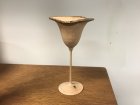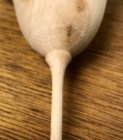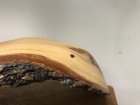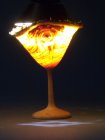I have been trying to turn some pieces of black cherry before they are to far gone. One of my pet peeves is many turners seam to think that you have to dry the wood before turning and then they complain about all of the cracks that inevitably develop. The basics of the effects of drying wood is the shrinkage coupled with stress in the wood. The problem with drying a bowl blank is that the moisture can only escape from the exposed surfaces and end grain will give up moisture the fastest and cause checking in those areas. The large mass in a blank effectively seals in the moisture and if it ever does dry the radial and tangential shrinkage will cause major cracks. The one method that works is to rough turn to a uniform thickness which provides more surface area for the moisture to escape and allows distortion to relieve the effects of shrinkage. The second method is to turn to a very thin wall and live with the distortion.
 This photo shows a black cherry bowl from a crotch with the bottom or main pith facing and you can see the cracks that were there before I started turning.
This photo shows a black cherry bowl from a crotch with the bottom or main pith facing and you can see the cracks that were there before I started turning.
 This photo shows the top with 2 main piths and 1 smaller pith but no cracks.
This photo shows the top with 2 main piths and 1 smaller pith but no cracks.
The photos do not show it clearly but all 3 of the major piths bulge out and the sap wood between the piths is uneven. The small shallow bowl on to is a loss since it distorted so badly on it's bass but I had to try.
The bowl was turned t a relatively uniform wall thickness of .09" to.04" then sanded with Abrnet all before it dried
 This photo shows a black cherry bowl from a crotch with the bottom or main pith facing and you can see the cracks that were there before I started turning.
This photo shows a black cherry bowl from a crotch with the bottom or main pith facing and you can see the cracks that were there before I started turning. This photo shows the top with 2 main piths and 1 smaller pith but no cracks.
This photo shows the top with 2 main piths and 1 smaller pith but no cracks.The photos do not show it clearly but all 3 of the major piths bulge out and the sap wood between the piths is uneven. The small shallow bowl on to is a loss since it distorted so badly on it's bass but I had to try.
The bowl was turned t a relatively uniform wall thickness of .09" to.04" then sanded with Abrnet all before it dried






